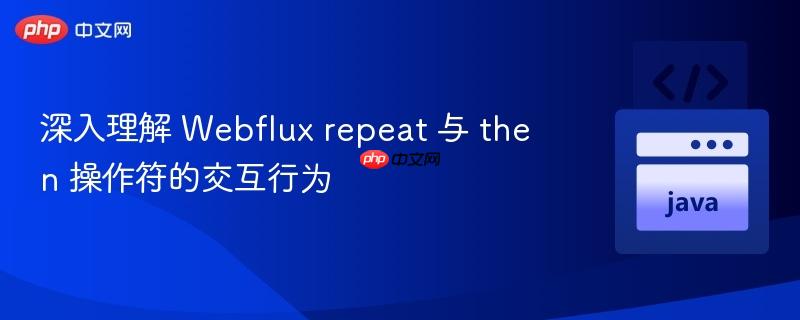
本文旨在深入探讨 webflux 中 `repeat` 和 `then` 操作符的独特行为及其相互作用。`repeat` 操作符会使其上游序列重新订阅并重复执行,而 `then` 操作符则在等待其上游流(包括所有重复)完全完成后,才执行一次并转换为一个新的 `mono` 流。理解这两个操作符的相对位置对流的执行顺序和结果至关重要。
在 Webflux 响应式编程中,操作符的组合和顺序对流的行为有着决定性的影响。repeat 和 then 是两个功能强大但有时行为可能出乎意料的操作符。本教程将通过具体示例,详细解析它们各自的特性以及在不同组合下的交互逻辑。
repeat 操作符的作用是使其上游的响应式序列在完成后重新订阅,从而重复发出元素。它会将一个 Mono 转换为一个 Flux,或者使一个 Flux 重复其元素序列。
考虑以下示例:
import reactor.core.publisher.Mono;
public class RepeatExample {
public static void main(String[] args) {
// 示例 1: repeat 在所有 doOnNext 之后
System.out.println("--- 示例 1 ---");
Mono.just(5)
.doOnNext(i -> System.out.println("next 1: " + i))
.doOnNext(i -> System.out.println("next 2: " + i))
.doOnNext(i -> System.out.println("next 3: " + i))
.repeat(2) // 原始序列重复 2 次,总共执行 3 次
.subscribe();
// 示例 2: repeat 在 doOnNext 之间
System.out.println("\n--- 示例 2 ---");
Mono.just(5)
.doOnNext(i -> System.out.println("next 1: " + i))
.repeat(2) // 原始序列重复 2 次,总共执行 3 次
.doOnNext(i -> System.out.println("next 2: " + i))
.doOnNext(i -> System.out.println("next 3: " + i))
.subscribe();
}
}输出:
--- 示例 1 --- next 1: 5 next 2: 5 next 3: 5 next 1: 5 next 2: 5 next 3: 5 next 1: 5 next 2: 5 next 3: 5 --- 示例 2 --- next 1: 5 next 2: 5 next 3: 5 next 1: 5 next 2: 5 next 3: 5 next 1: 5 next 2: 5 next 3: 5
分析: 从这两个示例可以看出,repeat(2) 表示在原始序列完成之后,会再重新订阅并执行两次,总共执行三次。无论 repeat 操作符放在 doOnNext 链的哪个位置,它都会使其上游的整个序列重新订阅。这意味着,一旦 repeat 被应用,它会将其上游的 Mono 或 Flux 转换为一个重复序列的 Flux,而后续的 doOnNext 操作符则会作用于这个重复序列的每个元素。因此,即使 repeat 位于 doOnNext("next 1") 之后,doOnNext("next 2") 和 doOnNext("next 3") 依然会在每次重复时被执行。
then 操作符用于在当前响应式序列完成时,切换到一个新的 Mono 流。它会等待上游序列发出所有元素并成功完成(onComplete)后,才订阅并执行 then 中传入的 Mono。then 的一个关键特点是它会把流的类型从 Flux 或 Mono 转换为一个 Mono,并且这个 Mono 只会发出一个元素(或不发出任何元素)。
当 repeat 和 then 结合使用时,它们的相对位置会极大地影响流的执行逻辑。
import reactor.core.publisher.Mono;
public class ThenBeforeRepeatExample {
public static void main(String[] args) {
System.out.println("--- 场景一: then 在 repeat 之前 ---");
Mono.just(5)
.doOnNext(i -> System.out.println("next 1: " + i))
.doOnNext(i -> System.out.println("next 2: " + i))
.then(Mono.just("hello")) // 转换流,等待上游 Mono<Integer> 完成后发出 "hello"
.doOnNext(s -> System.out.println("next 3: " + s)) // 作用于 "hello"
.repeat(2) // 重复整个 then 后的 Mono<String> 序列
.subscribe();
}
}输出:
--- 场景一: then 在 repeat 之前 --- next 1: 5 next 2: 5 next 3: hello next 1: 5 next 2: 5 next 3: hello next 1: 5 next 2: 5 next 3: hello
分析:
在此场景中,then(Mono.just("hello")) 会在上游的 Mono.just(5) 完成(即 doOnNext("next 1") 和 doOnNext("next 2") 执行完毕)后,发出一个 "hello" 字符串。此时,整个流的类型已经从 Mono
import reactor.core.publisher.Mono;
public class ThenAfterRepeatExample {
public static void main(String[] args) {
System.out.println("--- 场景二: then 在 repeat 之后 ---");
Mono.just(5)
.doOnNext(i -> System.out.println("next 1: " + i)) // Mono<Integer>
.repeat(2) // 转换为 Flux<Integer>,重复上游 Mono 3 次
.doOnNext(i -> System.out.println("next 2: " + i)) // 作用于 Flux<Integer> 的每个元素
.then(Mono.just("hello")) // 等待上游 Flux<Integer> (包括所有重复) 完成后,发出 "hello"
.doOnNext(s -> System.out.println("next 3: " + s)) // 作用于 then 发出的 "hello"
.subscribe();
}
}输出:
--- 场景二: then 在 repeat 之后 --- next 1: 5 next 2: 5 next 1: 5 next 2: 5 next 1: 5 next 2: 5 next 3: hello
分析: 这是最能体现 repeat 和 then 交互特性的场景。
Webflux 的 repeat 和 then 操作符虽然功能强大,但在组合使用时需要对其内部机制有清晰的理解。repeat 负责上游序列的重新订阅,而 then 则在等待上游流(包括所有重复)完成后进行一次性转换。掌握它们各自的特性以及它们如何改变流的类型和执行边界,是编写高效、可预测的响应式应用程序的关键。通过本文的示例和分析,希望能够帮助开发者更深入地理解这两个操作符的精妙之处。
以上就是深入理解 Webflux repeat 与 then 操作符的交互行为的详细内容,更多请关注php中文网其它相关文章!

每个人都需要一台速度更快、更稳定的 PC。随着时间的推移,垃圾文件、旧注册表数据和不必要的后台进程会占用资源并降低性能。幸运的是,许多工具可以让 Windows 保持平稳运行。

Copyright 2014-2025 https://www.php.cn/ All Rights Reserved | php.cn | 湘ICP备2023035733号